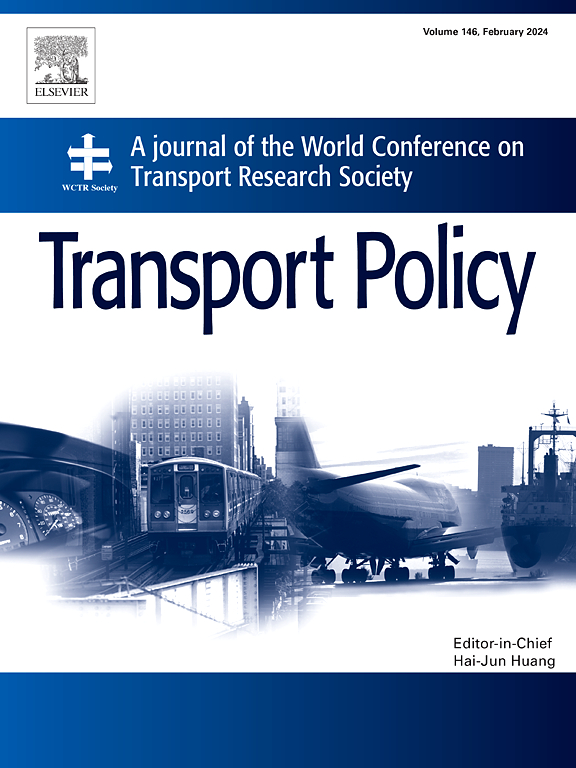司机的出行目的和碰撞前机动作为行人伤害严重程度的决定因素:见解和政策建议
IF 6.3
2区 工程技术
Q1 ECONOMICS
引用次数: 0
摘要
行人安全是可持续城市交通的重要组成部分。尽管步行具有众所周知的社会和健康益处,但行人仍然是道路上最脆弱的群体之一,由于缺乏人身保护,他们经常在车祸中受到严重伤害。为了解决这一问题,鼓励步行的政策必须与加强安全的措施齐头并进。本研究调查了影响英国城市道路上行人碰撞严重程度的危险因素,重点关注驾驶员的旅行目的和碰撞前机动的未充分开发的作用。通过时间分析,该研究揭示了司机的出行目的,特别是“通勤出行”和“与工作相关的出行”,与严重的行人伤害显著相关。该分析进一步探讨了碰撞前的行为,发现车辆的动作,如倒车、转弯、停车/启动,以及行人的动作,如从驾驶员的越位过马路或沿着道路行走,都会显著影响伤害结果。虽然在车辆转弯、倒车和行人行走时更有可能受到轻伤,但致命伤害与像行人过街这样的高风险操作密切相关。这些发现为行人碰撞动力学提供了重要的见解,并可以为更有针对性的安全措施提供信息。政策建议包括制定量身定制的交通管理策略,例如限制行人密集地区的某些高风险机动,降低城市地区的限速,以及采用先进的车辆安全技术。此外,开展宣传活动,强调工作或通勤途中特定驾驶行为带来的危险,有助于降低风险。加强对出租车、卡车和公共汽车运营商的驾驶员培训,特别是在城市地区,并实施针对驾驶员疲劳的工作场所安全计划,可以改善道路安全。最后,强调行人能见度和安全过马路行为的公众意识活动对于减少行人的脆弱性至关重要。将这些见解纳入更广泛的城市交通规划,并采用更严格的行人安全法规,将支持更有效的干预措施,旨在降低行人受伤严重程度,加强城市环境中的道路安全。本文章由计算机程序翻译,如有差异,请以英文原文为准。
Drivers' trip purpose and pre-crash maneuvers as determinants of pedestrian injury severity: Insights and policy recommendations
Pedestrian safety is a critical component of sustainable urban mobility. Despite the known societal and health benefits of walking, pedestrians remain one of the most vulnerable groups on the road, often suffering severe injuries in crashes due to their lack of physical protection. To address this issue, policies encouraging walking must go hand in hand with measures that enhance safety. This study investigates the risk factors affecting pedestrian crash severity on urban roads in the United Kingdom, with a focus on the underexplored role of drivers' trip purposes and crash preceding maneuvers.
Using a temporal analysis, the study reveals that drivers' trip purposes, particularly ‘commuting trips' and ‘work-related journeys’, are significantly associated with serious pedestrian injuries. The analysis further explores crash preceding actions, finding that vehicle maneuvers such as reversing, turning, and stopping/starting, as well as pedestrian movements such as crossing from the driver's offside or walking along roadways, significantly impact injury outcomes. While minor injuries are more likely during vehicle turning, reversing, and pedestrian road-walking, fatal injuries are strongly associated with maneuvers like pedestrian crossings that involve higher risk.
These findings provide essential insights into pedestrian crash dynamics and can inform more targeted safety measures. Policy recommendations include developing tailored traffic management strategies, such as limiting certain high-risk maneuvers in pedestrian-dense areas, lowering speed limits in urban areas, and adopting advanced vehicle safety technologies. Additionally, creating awareness campaigns that emphasize the dangers posed by specific driver behaviors during work-related or commuting trips could help mitigate risks. Enhancing driver training for taxi, truck, and bus operators, particularly in urban areas, and implementing workplace safety programs targeting driver fatigue could improve road safety. Finally, public awareness campaigns emphasizing both pedestrian visibility and safe crossing behaviors are crucial for reducing pedestrian vulnerability. Integrating these insights into broader urban transport planning and adopting stricter pedestrian safety regulations would support more effective interventions aimed at reducing pedestrian injury severity and enhancing road safety in urban environments.
求助全文
通过发布文献求助,成功后即可免费获取论文全文。
去求助
来源期刊

Transport Policy
Multiple-
CiteScore
12.10
自引率
10.30%
发文量
282
期刊介绍:
Transport Policy is an international journal aimed at bridging the gap between theory and practice in transport. Its subject areas reflect the concerns of policymakers in government, industry, voluntary organisations and the public at large, providing independent, original and rigorous analysis to understand how policy decisions have been taken, monitor their effects, and suggest how they may be improved. The journal treats the transport sector comprehensively, and in the context of other sectors including energy, housing, industry and planning. All modes are covered: land, sea and air; road and rail; public and private; motorised and non-motorised; passenger and freight.
 求助内容:
求助内容: 应助结果提醒方式:
应助结果提醒方式:


